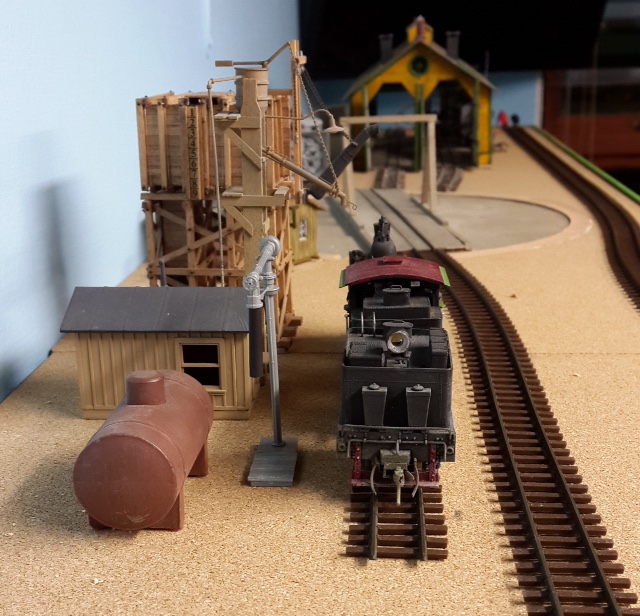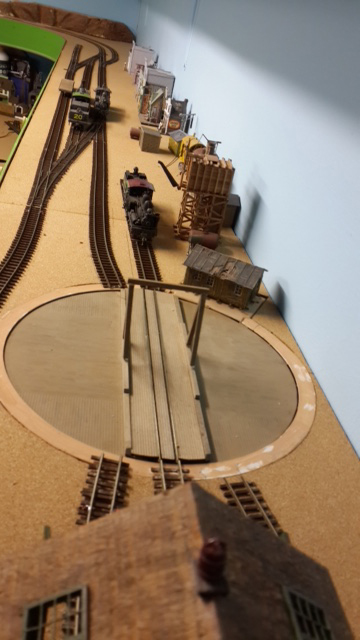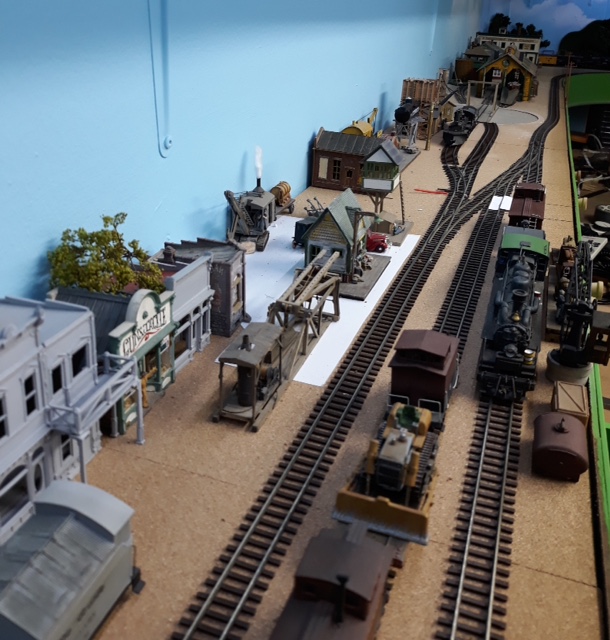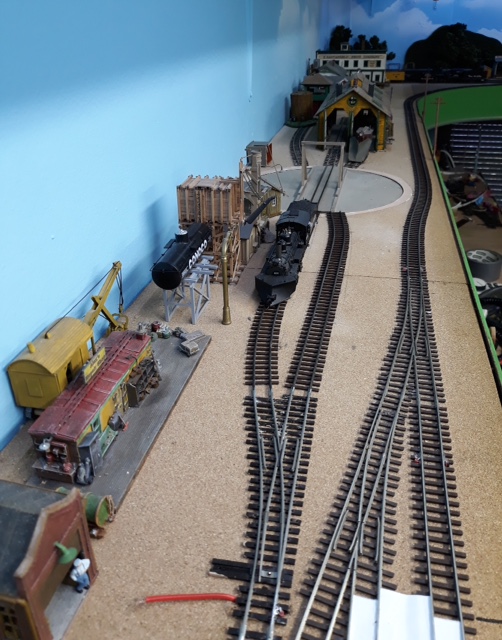Brian’s been in touch with the latest update to his shelf model railroad.
“Hi Al,
I thought that I was finished with everything and ready to landscape the rest of the layout, looked back to admire my workmanship when something came to my attention.
I was doing a bit of running trains (shunting) and delivering cars to their respective industries when a thought suddenly came to mind, how do I deliver a tank car to the oil refueling tank in the yard. I have one inbound/outbound track from the turntable and in this case, cannot deliver from the turntable.
Never mind he thinks, simple solution by adding a point and curving the track away from the turntable, called in the track gang and low and behold, a siding where I can make deliveries of Oil, Sand and other locomotive facility stuff.
Never to late to make a few small changes.
I will send a few photos later of the completed new section as soon as the backdrop dries and the strip lights added.
As they say, learn from your mistakes.
Photo below is the old track layout from the turntable.
This photo below shows the mistake of not being able to supply the facilities. Engine House tracks are not aligned with the turntable yet in these early photos.
The two photos below show the added point and adding a new section of track enabling deliveries to the facilities.
The two tracks now serve as inbound and outbound to and from the Engine house and service track on the side.
Problem solved and completed in two hours including mounting the point motor underneath and the control knob on the facia board.
Note to self, remove unwanted red wire before continuing.
(Photos are always very good at pointing out these problems – thats why I take a lot of them to make sure that I have not missed something, like adding sleepers in the gaps under the rail). Remembering that my layout is just below eye level and not easy to see this.
That’s all for now and all the best.
Brian”
For a shelf model railroad, Brian really is packing everything in to it.
Can’t wait to see the next update (his last post is here by the way).
“Alastair,
No one I’ve talked to on this side of the pond seems to know the answer to this question: Why do many European locomotives have long steel panels on either side of the boiler? What is/was their purpose?
Thanks,
Bob
Okeechobee, Florida
p,s.
Really enjoy your site.”
That’s all for today folks, please do keep ’em coming.
And if you think everyone else is having all the fun, the Beginner’s Guide is here.
Best
Al






Those long sheets of metal are smoke deflectors, often called elephant ears. Their purpose is to create air pressure at the front of locomotive that pushed smoke up away from the cab windows. They were used at times on US railroads, but were much more prevalent in Europe especially on German locomotives.
Hi Bob,
When you see long steel panels on either side of the boiler are you looking at a (side) tank engine? The water tanks, plus a coal bunker behind the cab, replace the tender. You end up with a loco which is just as happy running bunker first as it is chimney first, also, you put more weight on the driving wheels to obtain more adhesion. Tank locos were for used for switching and for intense suburban passenger work where it was an advantage not to have to turn the loco. ( I guess they accelerated pretty well too)
The drawbacks were limited coal capacity and, in some circumstances, the extra axle loading. If you google the ‘Lauder Branch’, you will see photos of a Scottish shortline where tank engnes ran with empty tanks + a tender to spread the weight on a lightly constructed rural line.
I’d say that smoke deflectors are fairly short steel panels on either side of the smoke box. Side tanks would present long steel side panels on either side of the boiler.
Bob, these are smoke deflectors, sometimes called “blinkers” in the UK because of their strong resemblance to the blinkers used on horses, and like mentioned above “elephant ears” in US railway slang. They are vertical plates attached to each side of the smokebox at the front of a steam locomotive. They are designed to blow steam and smoke away from the locomotive, and only work at speed so that the driver has better visibility. A hand valve in the cab can be opened to blow steam up from the bottom of the smokebox when the engine is sitting still to keep the smoke from moving down onto the cab and preventing seeing to the front of the engine (signals, people, animals on the track). Another pipe can be connected to compressed air lines to blow up through the smokebox, but this is to create a draft to assist in building the fire when a cold engine is being started.
In the U.S. west, there were several designs of “smoke-lifters” which were mechanical extensions of the stack which engineers could adjust to get the highest lift of smoke based on the speed of the engine, and the amount of smoke being created.
Re; Elephant ears. TOO realistic a device. I’d leave ’em off if I could. Spoils the lines and the detail of the engine. There is no smoke to deflect anyway..
On miniature layouts , visibility is fine
Nice idea.
I always thought the panels were armor to protect the engines from being straffed during WWII.
Re: Brian’s shelf RR, I get the sexiness of a turntable. However, while not wishing to be a wet blanket, I nevertheless (as a cost conscious CEO operator) suggest that my Board of Directors would have fired me when a pair of turnouts would have pragmatically better solved operations and cut labor costs. Is this why railroads die? Just because you can doesn’t mean you should..
great sruff Brian….
good detail and accurate too
keep em runnin fellas
stJohn in long beach calif
Makes sense. Now he has an inbound track and an outbound track for the shop crews to use. Bud
Hi, Just thought I’d mention that real railroads use progressive differential curves. You don’t just slam into a hard curve but ease into it little by little. Often otherwise very realistic layouts miss this point.
I always enjoy your posts and look forward to them.
Bob
Great job Brian!
American short line railroads and narrow gauge railroads usually had a turntable to service the enginehouse as shown. They also often had one at the terminus of certain branch lines where space was limited and there was a need to turn locomotives end for end. Brian’s engine terminal reflects this well.
To service the fueling area, that was usually a separate siding and not fed from the turntable… Usually…
I always thought that a turntable was to turn the old steam locos around, not for running cars across. Oh well what do I know?
NV Bob
I don’t care what anybody says, Brian, I like your layout. It’s your railroad after all, and how you run it is your business. Warren, AL, USA
great update and video thanks for sharing.
Hi, If Bob from Florida means the casing that extends all the way down the boilers to the cab, then in many cases it was to reduce wind resistance when the companies were after the speed record prestige, as well as providing sleek attractive lines for the marketing art of the era.
eg Mallard./ Union of South Africa types of the LNER designed by Sir Nigel Gresley, Coronation Class types of the LMS designed by Sir William Stanier & Battle of Britain Class & City Locos of the Southern Region, designed by Oliver Bullied..
I am not aware of any streamlined panelling or Smoke deflectors on the GWR.
Brian,
I’m glad you noticed that problem with the fueling service off the turntable. Frankly, when I saw the first (older) photo, I wondered “Why does an engine have to cross the turntable to be refueled and then go back on the turntable to get out of the engine service area?” Your new track arrangement makes a lot more sense as well as allowing for easy delivery of fuel oil, sand and coal to the refueling structures. Is that an N-scale turntable that you’ve modified for HOn3?
Hi Will, it is modified HO Atlas turntable with the HOn3 track on the top.
Brian- the HOn3 guy in Knysna RSA
When a steam locomotive is moving forward, the air in front of the train is forced against the smoke box and its door. This air is then ‘spread’ apart and creates a partial vacuum around and behind the edge of the smoke box. The ‘spread’ air then creates swirling currents that draw down the smoke and block the drivers view forward. This is fixed by physically stopping the air from creating the partial vacuum. By putting the smoke deflectors on the sides of the smoke box, the ‘spread’ air is forced backwards by the oncoming air. The curved top to the smoke deflectors channels the air into an updraft, the updraft is created by the convection of the hot exhaust, which lifts the smoke from the chimney away from the drivers forward view. So smoke deflectors don’t actually deflect the smoke, rather they deflect the air. Nice start Brian! Have fun with it, love your buildings. Looking forward to seeing your progres!
OLDTAZ
Look great? I hope mine comes out that goods.